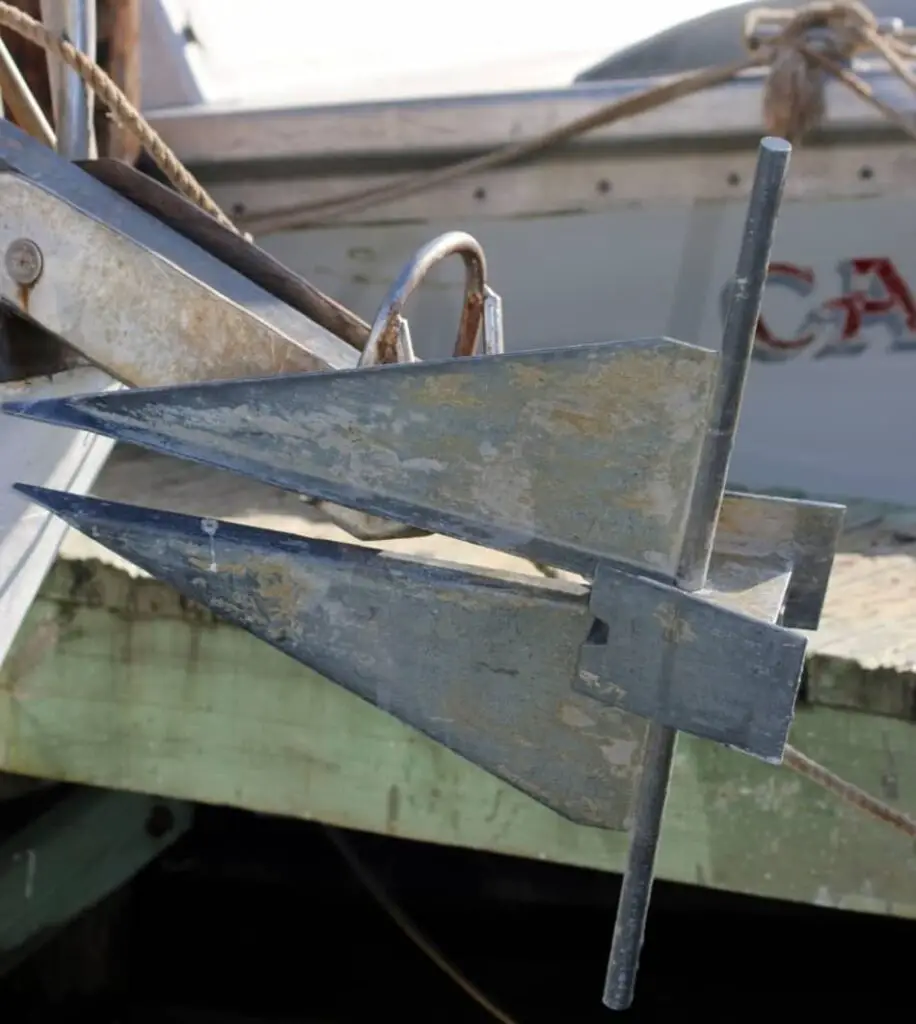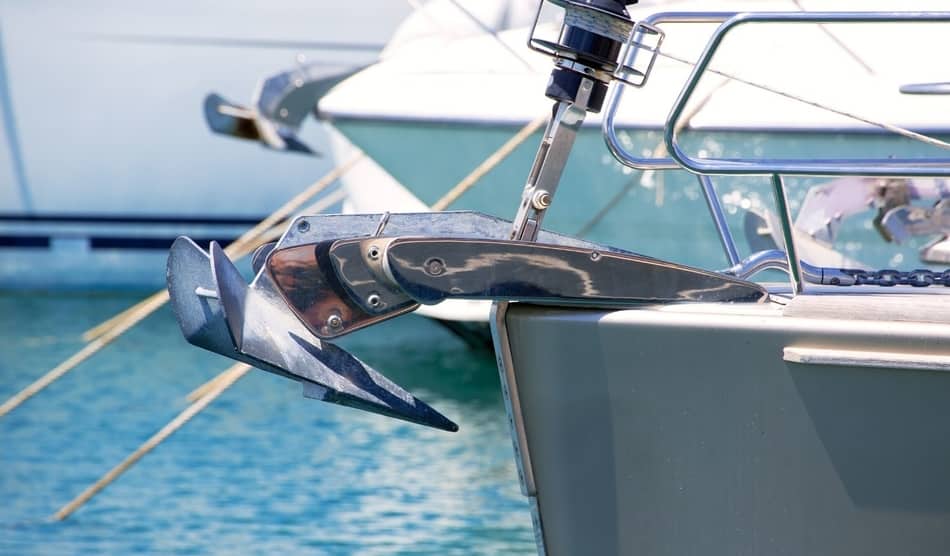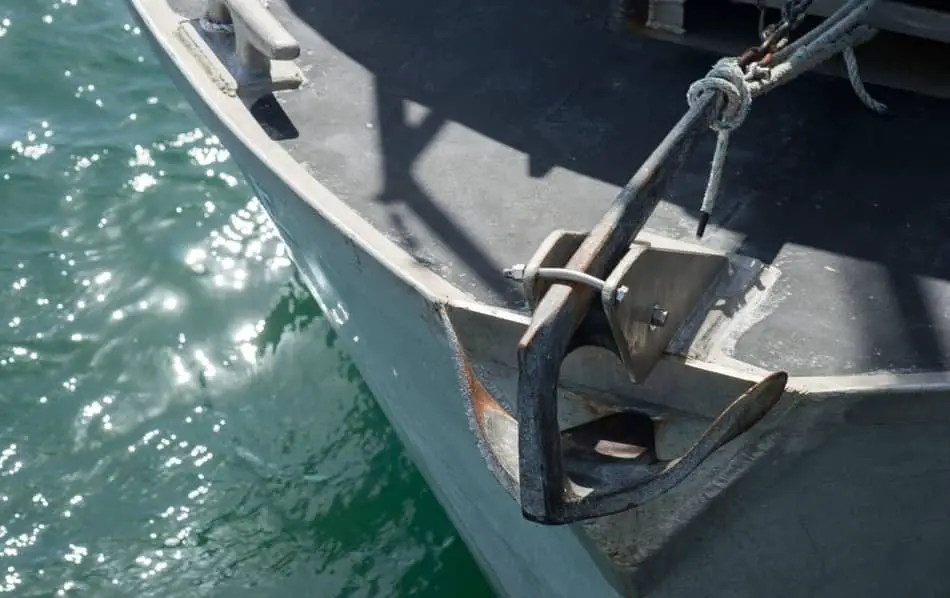Mud bottom is the most common type of bottom you will see while boating. Here are some tips for choosing a boat anchor for the muddy bottom.
The best boat anchor for mud bottoms is Fluke, Delta, and Bruce anchors. Among them, Fluke anchors are best because it has two big flukes providing a better holding power. Still, you can use delta, bruce, cqr, and modern anchors. But, Fluke anchors are good for muddy bottoms (worthy).
All types of anchors are best for mud bottoms (fluke, cqr, delta, bruce, and modern). But Fluke anchors are worth buying for a mud bottom. If you are boating in only these types of bottoms (mud), then take only fluke anchors. If you do boating in different places or different kinds of bottoms, then choose modern or other anchors (but, if you have a big boat, then go for big anchos such as modern, cqr, delta, and bruce.
For boating only in mud bottom types, fluke anchors are sufficient (but, only for small boats, not for big boats). You don’t need to buy other expensive anchors such as modern, delts, CQR, and bruce (still, those are excellent anchors). But if you have a big boat, then don’t buy fluke anchors because fluke anchors are lightweight type anchors, and may not work well for big boats.
As I said, for mud bottoms, fluke, delta, and bruce anchors suit well. That doesn’t mean that those types of anchors (fluke, delta, and bruce) will work only in the mud bottom. For example, fluke anchors work well in mud, sand, silt, and clay bottoms as well.
Similarly, delta anchors will set well in mud, sand, clay, silt, grass, weed rocks, and gravel bottoms, and bruce anchors will set well in mud, sand, and silt bottoms. Like that, if you buy one anchor, it will work well in at least 2 or 3 bottom types as well.
Meaning you should not only consider only one bottom type while buying an anchor for your boat. For example, if you purchase fluke anchor (thinking you will go for boating only in mud bottoms), generally, fluke anchors will not work well in grass, weed, and rocky bottoms.
And, all the time, you may not go for boating only in a specific (or the same place) place. Sometimes, you might change the location, and if you change the location, then sometimes you might encounter some other types of bottom conditions. Then you may not be able to use that fluke anchor. So, you should consider all these things while buying an anchor.
Now, that you have been selecting an anchor for a mud bottom, those three anchors (fluke, delta, and bruce) will work well in muddy bottoms. Now, let’s see those three anchors in detail.
To get more info about the different bottom types and the different anchors, check my article on Choosing a perfect anchor for your boat: All you need to know (opens in a new tab). It is a detailed analysis of all the bottom types and their respective anchors that suit for all those bottom types.
1. Fluke or Danforth anchor

Fluke or Danforth anchors are the most popular anchors. Many boaters will use these anchors in their boats. We will now see for which type of bottom types we will use these Danforth or fluke anchors.
Fluke or Danforth anchors are used in the bottoms like sand, mud, clay, and silt. In hard clay bottoms, Fluke or Danforth anchors won’t set as nicely as it sets in normal bottoms. Still, it is a good option for clay bottoms. Fluke anchors are not suitable for rock, gravel, weed, and grass bottoms.
Image is linked to Amazon

Fluke or Danforth anchor (linked to Amazon). Check the price in amazon, and it is worth buying a fluke anchor for mud, clay, sand, and silt bottom.
| Fluke anchors | Setting ability (for 5 points) | Resetting ability (for 5 points) | Holding power (for 5 points) | Robust (for 5 points) |
| Mud | 4 | 3 | 5 | 4 |
| Sand | 4 | 3 | 5 | 5 |
| Grass | 1 | 1 | 2 | 1 |
| Weed | 1 | 1 | 2 | 1 |
| Rock | 1 | 1 | 1 | 1 |
| Gravel | 1 | 1 | 1 | 1 |
| Silt | 5 | 4 | 5 | 4 |
| Clay | 4 | 3 | 4 | 4 |
Due to its fluke design, it will penetrate well in the mud. These anchors are very light in weight. The stock is hinged so the flukes can penetrate toward the bottom. For some designs, you can adjust the optimal angle depending on the bottom type.
These anchors penetrate well at the bottom. Once, if it sets well at the bottom, then it can develop high resistance. Its lightweight and compact flat design make it easy to retrieve and relatively easy to stow. There is another type of Fluke or Danforth anchor.
The other type of fluke anchor is the Fortress anchor. The Fortress is an American aluminum alloy Danforth variant. It can be disassembled for storage, and it features an adjustable 32° and 45° shank/fluke angle to improve holding capability in bottoms such as hard sand and soft mud.
Danforth anchors reset well, and the fortress anchor will not reset like a Danforth anchor. A Danforth will not usually penetrate or hold in gravel or weed or rock bottoms. In the below table, I listed the Fluke or Danforth anchor size based on the boat size (source). The values may vary a little bit if the boat weight is heavy or very light.
| Anchor Weight (in lbs.) | Boat Length (in feet) | Holding Power (in lbs.) |
| 3.5 lbs. | < 10 feet | 160 lbs. |
| 5 lbs. | 10-17 feet | 300 lbs. |
| 9 lbs. | 17-27 feet | 600 lbs. |
| 14 lbs. | 27-31 feet | 920 lbs. |
| 16 lbs. | 31-36 feet | 1300 lbs. |
| 25 lbs. | 36-40 feet | 1600 lbs. |
| 43 lbs. | 40-45 feet | 2000 lbs. |
| 70 lbs. | 45-55 feet | 3000 lbs. |
| 100 lbs. | 55-60 | 3500 lbs. |
The advantages of Fluke or Danforth anchor and Fortress anchor
- Fluke anchors are excellent in normal mus, sand, silt, and clay bottom types.
- Fluke anchors are very light in weight.
- Fluke anchors can be stowed well in the boat.
- Fluke anchors can be disassemblable.
- Fluke anchors are inexpensive compared to other style anchors.
- Fluke anchors will be the right choice for small boats because fluke anchors are lightweight type anchors.
The disadvantages of Fluke or Danforth anchor and Fortress anchor
- Fluke anchors are not suitable for rock, gravel, weed, and grass bottom types.
- Fluke anchors have less holding power than other anchors.
- Fluke anchors will not reset easily if the wind or current shifts.
- Fluke anchors are not the right choice for big boats because these are lightweight anchors and may not work well for big boats.
- The anchor flukes might bend if you use fluke anchor in rock or gravel bottoms.
2. Delta or Wing anchor or Non-hinged anchor

Delta or Wing anchors are also known as non-hinged anchors, and one of the good anchors. Delta or Wing anchors are many ways similar to CQR or Plow anchors. We will now see for which type of bottom types we will use the Delta or Wing anchors.
The Delta or Wing anchors are used in the bottoms like rocks, gravel, grass, clay, sand, mud, weed, and silt. But in the grass, weed, and very soft bottoms, Delta or Wing anchors won’t set as nicely as it sets in normal bottoms. Still, they are okay for weed, grass, and very soft bottom types.
Image is linked to Amazon

Delta or wing anchor (linked to Amazon). Check the price in amazon, and it is worth buying a Delta or wing anchor for rocks, gravel, clay, sand, mud, grass, and silt bottom. But if you are thinking of purchasing a delta anchor, then you should know that sometimes in weed, grass, and very soft bottoms, the delta anchor may not set well at the bottom. Consider that point while buying a delta anchor.
| Delta anchors | Setting ability (for 5 points) | Resetting ability (for 5 points) | Holding power (for 5 points) | Robustness (for 5 points) |
| Mud | 4 | 4 | 5 | 4 |
| Sand | 4 | 3 | 5 | 5 |
| Grass | 4 | 3 | 4 | 2 |
| Weed | 3 | 3 | 4 | 3 |
| Rock | 4 | 3 | 4 | 4 |
| Gravel | 4 | 4 | 4 | 4 |
| Silt | 5 | 4 | 5 | 5 |
| Clay | 5 | 4 | 4 | 5 |
Delta or Wing anchors can be stowed conveniently in a roller at the bow, and have been popular with cruising sailors and private boaters. Delta or Wing anchors are generally good in all types of bottoms, except soft bottoms.
But, Delta or Wing anchor cannot be stowed inside the boat properly because we can’t disassemble a delta anchor. You need to consider all these things while buying a Delta or Wing type anchor.
In the below table, I listed the Delta or Wing anchor size based on the boat size (source). The values may vary a little bit if the boat weight is heavy or very light.
| Anchor Weight (in lbs.) | Boat Length (in feet) |
| 13 lbs. | 17-29 feet |
| 22 lbs. | 30-40 feet |
| 33 lbs. | 40-49 feet |
| 44 lbs. | 47-57 feet |
| 55 lbs. | 53-63 feet |
| 66 lbs. | 57-70 feet |
The advantages of Delta or Wing anchors
- Delta anchors are excellent in mud, sand, silt, rocks, gravel, clay, grass, and weed bottoms (sometimes, may not work well in weed and very soft bottoms).
- Delta anchors can be stowed conveniently in a roller at the bow.
- Delta anchors penetrate deep into the bottom and have good holding power.
- Delta anchors will be the right choice for big boats because these are heavy anchors.
The disadvantages of Delta or Wing anchors
- Sometimes, Delta anchors will not set properly or holds less in the weed and very soft bottoms.
- Delta anchors can’t be stowed easily in the boat due to its hinge design.
- Delta anchors take time to set at the bottom.
3. Bruce or Claw anchor

Bruce or Claw anchors are another type of famous anchors. It looks like a claw. It has three claws on it, which makes it easy to handle many kinds of bottom conditions. We will now see for which type of bottom types we can use the Bruce or Claw anchors.
Bruce or Claw anchors are used in the bottoms like sand, mud, and silt. In rock, gravel, weed, grass, and hard clay bottoms, Bruce anchors won’t set as nicely as it sets in normal bottoms. You can pull the anchor back easily. Bruce anchors are more effective in large sizes than smaller ones.
Image is linked to Amazon

Bruce or claw anchors (linked to Amazon). Check the price in amazon, and it is worth buying a bruce or claw anchor for mud, sand, and silt bottom. But, if you are thinking of purchasing a bruce anchor, then you should know that sometimes in rock, gravel, weed, grass, and hard clay bottoms, the bruce anchor may not set well at the bottom. Consider that point while buying a bruce anchor.
| Bruce anchors | Setting ability (for 5 points) | Resetting ability (for 5 points) | Holding power (for 5 points) | Robustness (for 5 points) |
| Mud | 4 | 3 | 5 | 4 |
| Sand | 4 | 3 | 5 | 5 |
| Grass | 2 | 2 | 3 | 2 |
| Weed | 2 | 1 | 2 | 1 |
| Rock | 3 | 3 | 4 | 3 |
| Gravel | 3 | 2 | 4 | 3 |
| Silt | 5 | 4 | 5 | 5 |
| Clay | 2 | 1 | 3 | 1 |
Bruce or Claw type anchors won’t set quickly in most of the bottoms, but they have the strong ability of not breaking out with tide or wind changes, instead slowly turning in the bottom to align with the force. Sometimes, these anchors may roll down and hold with only one the claw, rather than three claws.
That is the main drawback of Bruce or Claw anchors. These anchors won’t penetrate easily in grass and weed. Bruce or Claw anchors are not suitable for grass or weed bottoms. Bruce or Claw anchors set well in the low scope. Bruce or Claw anchors are more effective in large sizes than smaller ones.
In the below table, I listed the Bruce or Claw anchor sizes based on the boat size (source). The values may vary a little bit if the boat is heavy or very light.
| Anchor Weight (in lbs.) | Boat Length (in feet) |
| 6 lbs. | 13-22 feet |
| 11 lbs. | 18-25 feet |
| 16 lbs. | 22-34 feet |
| 22 lbs. | 25-35 feet |
| 33 lbs. | 30-40 feet |
| 44 lbs. | 35-50 feet |
| 55 lbs. | 39-55 feet |
| 66 lbs. | 40-60 feet |
The advantages of Bruce or Claw anchors
- Bruce anchors are excellent in mud, sand, and silt bottoms.
- Bruce anchors stow easily on a bow roller.
- Bruce anchors have a strong ability to not breaking out with tide or wind changes.
- Once it sets at the bottom, then it will set or hold well at the bottom.
- Bruce anchors will be the right choice for big boats.
The disadvantages of Bruce or Claw anchors
- Bruce anchors will not set properly or holds less in rock, hard clay, gravel, grass, weed bottoms.
- Bruce anchor rolls over to the side easily, then it may hold with only one claw instead of three claws.
- Bruce anchors take more time to set at the bottom.
- Bruce anchors take more space and can’t be stowed easily in the boat.
Related posts
Check my article on Choosing an anchor for your boat click here
Check my article on boat anchors for Offshore (oceans or seas) click here
Check my article on boat anchors for sand bottom click here
Check my article on boat anchors for clay bottom click here
Check my article on boat anchors for grass bottom click here
Check my article on boat anchors for weed bottom click here
Check my article on boat anchors for rock bottom click here
Check my article on boat anchors for gravel bottom click here
Bottom line
All types of anchors are best for mud bottoms (fluke, cqr, delta, bruce, and modern). But Fluke anchors are worth buying for a mud bottom. If you are boating in only these types of bottoms (mud), then take only fluke anchors. If you do boating in different places or different kinds of bottoms, then choose modern or other anchors (but, if you have a big boat, then go for big anchos such as modern, cqr, delta, and bruce.
For boating only in mud bottom types, fluke anchors are sufficient (but, only for small boats, not for big boats). You don’t need to buy other expensive anchors such as modern, delts, CQR, and bruce (still, those are excellent anchors). But if you have a big boat, then don’t buy fluke anchors because fluke anchors are lightweight type anchors, and may not work well for big boats.
As I said, one anchor will set well in different types of bottoms. So, choose an anchor that works well in the place where you will go for boating and some neighboring places as well. By doing that, one day if you go to another place for boating, then it will help you a lot.
